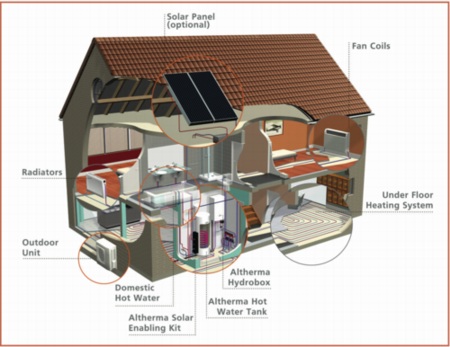Cost-effective renewable energy

Air-source heat-pumps are a well tried and very cost-effective way of harnessing renewable energy — according to figures that Darren Manley of Daikin UK shared with Ken Sharpe.
Darren Manley, manager of Daikin’s heating business in the UK, has no doubt of the enthusiasm of the industry for renewable energy. Not only has he seen a 30-fold increase the volume of the company’s Altherma air-source heat-pump system this year but has also been encouraged by installers to add a solar-thermal component to contribute to the generation of domestic hot water.
Solar thermal can be added to new installations or deferred until a later date to achieve a higher level in the Code for Sustainable Homes. The hot water is produced in a purpose-designed stainless steel tank, and the Daikin solar kit enables this tank to be connected to most modern solar collectors. Integrated control software assigns priority to solar-thermal energy, switching to heat-pump operation if energy from the solar collector is not sufficient. This arrangement enables 30 to 70% of the energy for domestic hot water to come direct from the Sun.
The rapid growth in the number of installed systems and communication with installers has given Darren Manley a growing appreciation of the capabilities of heat pumps. He has also drawn up a comparison of the relative cost effectiveness of air-to-water heat-pump systems such as Altherma compared with other forms of renewable energy.
Heat-pump technology is expensive compared with a boiler. However, the rate of VAT is only 5%, and grants are available.
Not only are heat pumps more expensive than boilers, but their cost increases more rapidly with increasing output. Accurate matching of heat-pump capability to requirements is vital to contain capital costs. An effective way of reducing the heating capacity required is to control a system so that domestic hot water takes priority over heating or the short periods that are needed to top-up the hot-water storage. The reduction in heating capacity is around 1 to 2 kW.
Another part of the strategy to optimise the balance of capital costs and running costs is to support the heat pump with direct-acting electric heating during cold periods. A rule of thumb is that 95% of the annual heat demand will be met by the heat pump and 5% by backup heating. The outdoor design temperature will depend on location.
The outdoor unit of a heat-pump installation can be self-contained, with only water connections to be made to the rest of the heating system, or linked to an indoor heat exchanger via refrigerant lines.
Altherma uses refrigerant lines, so this part of the system must be installed by a refrigeration engineer. However, Darren Manley is keen to highlight what he sees as a number of key benefits.
One is that a refrigerant-linked outdoor unit is smaller than a self-contained unit. Another is that a self-contained unit would have to be charged with glycol/water to avoid the risk of freezing. Not only is glycol expensive but it has a lower rate of heat transfer than water.
Using refrigerant lines to link indoor an outdoor unit also gives flexibility of siting, with a physical separation of up to 70 m.
Daikin’s approach is to use its Hydrobox as the interface between the outdoor unit and the indoor wet systems. An underfloor heating system with its low flow temperature has the greatest potential to achieve a high COP for the heat pump and, therefore, the lowest running cost. Other options include fan-coil units and conventional radiators sized for lower flow/return temperatures than traditional boilers.
Darren Manley also stresses that the outdoor unit of an Altherma system has inverter control. Benefits include a low starting current that does not exceed the maximum running current, enabling larger units to be operated from a single-phase electrical supply. Other benefits are accurate matching of supply to load, so a buffer tank is not required, and avoiding excessive stopping and starting of the compressor. Weather compensation is also readily achieved.
Darren Manley is convinced that air-source heat pumps are one of the most cost- and energy-effective forms of exploiting renewable energy — and he has drawn up figures to demonstrate his case.
The net cost to supply an install an 8 kW Altherma system, including VAT at 5% and MCS (Microgeneration Certification Scheme), is £4140. It will meet an annual heating required of 14 MWh, of which over 9.3 MWh will be renewable energy.
For comparison, a 2 kW solar PV system of 16 m2 would nave a higher net cost of £9050 and deliver 1.6 MWh of renewable energy a year.
While a solar-thermal system comprising two flat-plate collectors of 4 m2 has a lower net cost of £3800, it will deliver only 1.5 MWh a year of renewable energy.
Solar thermal with a gas-fired boiler will deliver both heating and hot water, but the net cost of £6150 will still deliver just 1.5 MWh a year of renewable energy.
A ground-source heat-pump installation will deliver the same renewable energy in a year as the Altherma system (9.3 MWh) but with a net cost of £8250 for horizontal collectors and £10 350 for boreholes.
That analysis can be summarised as renewable energy per year per £1000 spent.
•Photo-voltaic: 0.2 MWh.
•Solar thermal with boiler 0.4 MWh.
•Ground-source heat pump: 0.9 to 1.1 MWh.
•Air-source Altherma: 2.25 MWh.
A cost comparison between replacing an existing system with a condensing oil or gas boiler and an Altherma system is also illuminating. Allowing for grants and the different rates of VAT, the oil-fired system would cost £3642 and the gas-fired system £3172 . An Altherma system comes in at £4140. Compared to gas, the extra investment of £968 will deliver 9.3 MWh of renewable energy a year, or over 9.6 MWh per £1000 of extra investment.
Adding solar thermal to a gas-fired condensing boiler would cost nearly £3000 for 1.5 MWh a year of renewable energy, or 0.5 MWh per £1000.








